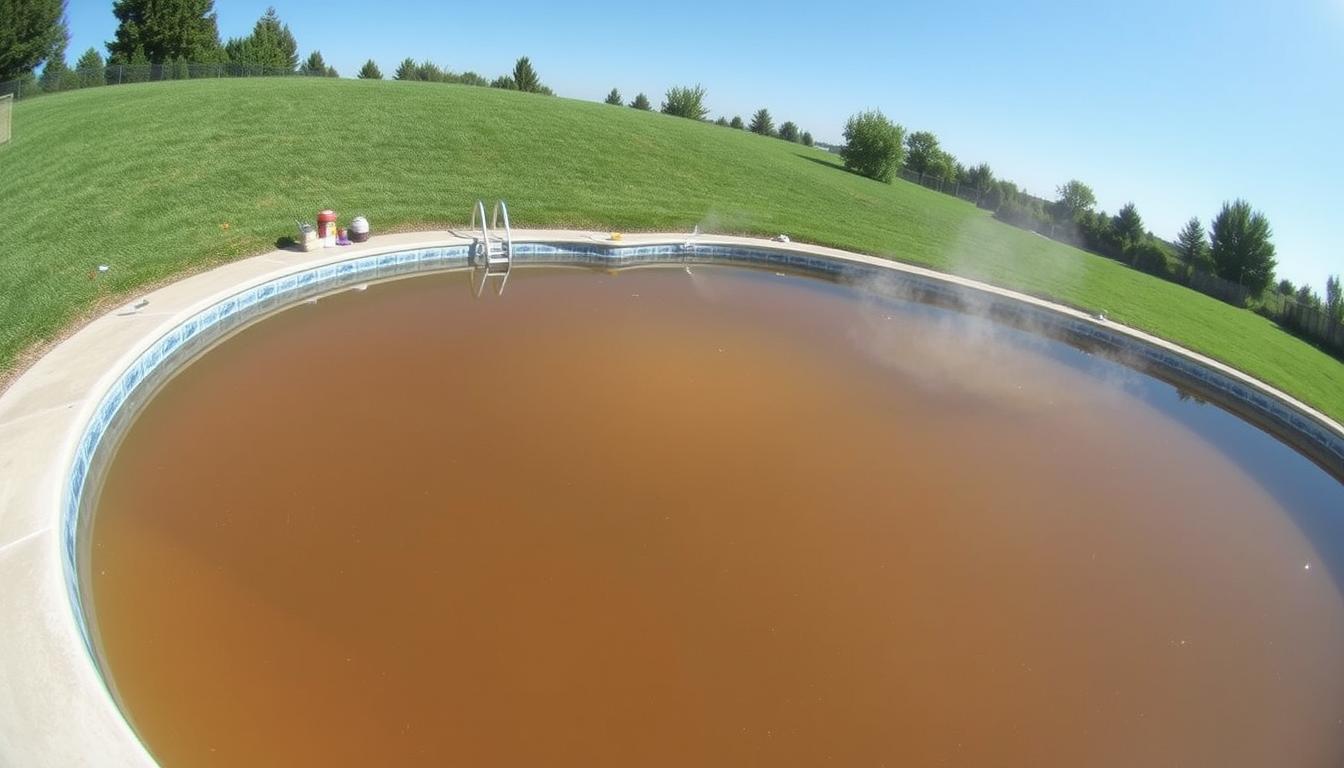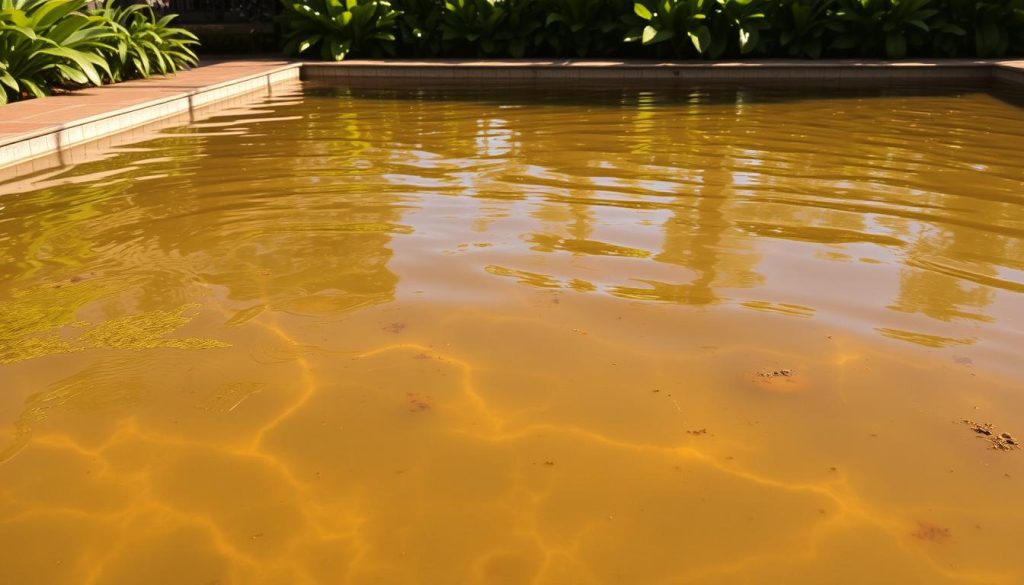
Regular water testing can prevent 90% of pool water quality issues. If your pool turned brown after adding chlorine, it’s likely due to iron in the water. This common problem occurs when chlorine oxidizes suspended iron particles.
Untreated iron buildup can stain your pool’s interior surface. This may lead to costly repairs and maintenance. Let’s explore the causes and solutions for this issue.
We’ll discuss metals in pool water and how to identify contamination sources. You’ll learn effective treatment methods to restore your pool’s clarity. Our guide will help you tackle various pool issues, from minor chlorine overdoses to algae growth.
Understanding Why Your Pool Turned Brown
Brown pool water can be frustrating and concerning. Several factors can cause this discoloration. Let’s explore these causes to help you identify the problem’s source.

Iron and Other Metals in Pool Water
Metal contaminants, especially iron, are main culprits behind brown pool water. Iron levels above 0.3 ppm can cause a brownish tint. Copper and manganese can also contribute to discoloration.
These metals can enter your pool through well water or rusting pool components. Well water often contains higher levels of dissolved metals. Rusting pipes or deteriorating heaters can introduce metals into the water.
Chlorine’s Effect on Metals
Chlorine causes dissolved metals to precipitate and become visible. This reaction often leads to brown water after shocking your pool. The oxidized metals form tiny particles that suspend in the water.
Even if your pool looked clear before, chlorine can trigger oxidation of existing metal contaminants. This can make the water turn brown unexpectedly.
Identifying the Source of Contamination
To treat brown pool water, identify the problem’s source. Test your pool water for iron, copper, and other metals. Use specialized test strips or a professional water testing service.
If you suspect your well water is the culprit, test it separately. Consider installing a pre-filter to remove metals before they enter your pool.
Organic debris on pool covers can also cause contamination. As leaves and twigs decompose, they release tannins. These can lead to tea-colored water when reopening your pool.
| Contaminant | Typical Source | Effect on Pool Water |
|---|---|---|
| Iron | Well water, rusting components | Brown or reddish tint |
| Copper | Pool heaters, algaecides | Blue-green staining |
| Manganese | Well water | Black or purple staining |
| Tannins | Decomposing organic matter | Tea-colored water |
Understanding these factors helps you tackle brown pool water effectively. Identifying specific contaminants allows for targeted solutions. With this knowledge, you can restore your pool’s crystal-clear appearance.
Solving the Brown Pool Water Problem
Brown pool water after adding chlorine needs quick action. We must find the cause and fix it fast. This way, we can make the pool water clean again.
Testing Pool Water for Metals
First, test for iron and copper in the pool water. Use metal test strips or a digital water test kit. This helps us choose the right treatment method.
Using Metal Removers and Chelating Agents
After finding metals, use metal removers and chelating agents. These products dissolve metal stains and gather particles for easy removal. High-quality metal sequestrants like BioGuard Pool Magnet Plus work well.
CuLator Metal Eliminator & Stain Preventer can also fight brown discoloration. These tools help combat the effects of oxidized metals in your pool.
Filtering and Vacuuming Techniques
Run the pool pump non-stop and vacuum particles to waste. This stops metals from recirculating in the pool. Use a good filter cartridge like Pleatco PPS6120.
A quality filter helps catch even the smallest metal bits. This ensures your pool water becomes clean and clear again.
| Product | Purpose |
|---|---|
| BioGuard Pool Magnet Plus | Chelating agent for filtering or vacuuming iron particles |
| CuLator Metal Eliminator & Stain Preventer | Captures suspended metal particles in pool water |
| Pleatco PPS6120 Filter Cartridge | Effective filtration for treating iron-related brown pool water |
| Pool Mate 1-2550 Metal Out | Chemical for eliminating iron stains in pool water |
Preventing Future Metal Buildup
Find and fix the source of metal contamination. For well water, install a pre-filter to remove metals. Keep pool chemistry balanced to prevent metal oxidation.
Maintain pH between 7.2 and 7.6. Keep chlorine levels between 1.0 and 3.0 ppm. This helps stop metal staining in your pool.
For tough metal stains, try vitamin C tablets or pH reducer powder. These can help remove stains and keep your pool looking great.
Test for metals, use removers, and filter well to solve brown pool water issues. Prevent future problems by maintaining proper chemistry and addressing the source of contamination.
Conclusion
Restoring a brown pool due to metal contamination is possible with the right approach. Understanding the causes, like iron reacting with chlorine, helps address the issue effectively. Identifying the contamination source is crucial for proper treatment.
Regular maintenance and water testing prevent future metal buildup. Metal removers and chelating agents can eliminate discoloration caused by oxidized metals. Proper filtering and vacuuming techniques also help restore clear water.
Consistent care is key to a beautiful, clear pool. Address water color changes quickly to maintain an inviting pool. With these practices, you’ll spend more time enjoying your refreshing oasis.







